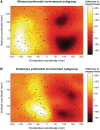The effects of the dopamine agonist rotigotine on hemispatial neglect following stroke
- PMID: 22761293
- PMCID: PMC3407421
- DOI: 10.1093/brain/aws154
The effects of the dopamine agonist rotigotine on hemispatial neglect following stroke
Abstract
Hemispatial neglect following right-hemisphere stroke is a common and disabling disorder, for which there is currently no effective pharmacological treatment. Dopamine agonists have been shown to play a role in selective attention and working memory, two core cognitive components of neglect. Here, we investigated whether the dopamine agonist rotigotine would have a beneficial effect on hemispatial neglect in stroke patients. A double-blind, randomized, placebo-controlled ABA design was used, in which each patient was assessed for 20 testing sessions, in three phases: pretreatment (Phase A1), on transdermal rotigotine for 7-11 days (Phase B) and post-treatment (Phase A2), with the exact duration of each phase randomized within limits. Outcome measures included performance on cancellation (visual search), line bisection, visual working memory, selective attention and sustained attention tasks, as well as measures of motor control. Sixteen right-hemisphere stroke patients were recruited, all of whom completed the trial. Performance on the Mesulam shape cancellation task improved significantly while on rotigotine, with the number of targets found on the left side increasing by 12.8% (P = 0.012) on treatment and spatial bias reducing by 8.1% (P = 0.016). This improvement in visual search was associated with an enhancement in selective attention but not on our measures of working memory or sustained attention. The positive effect of rotigotine on visual search was not associated with the degree of preservation of prefrontal cortex and occurred even in patients with significant prefrontal involvement. Rotigotine was not associated with any significant improvement in motor performance. This proof-of-concept study suggests a beneficial role of dopaminergic modulation on visual search and selective attention in patients with hemispatial neglect following stroke.
Figures







Similar articles
-
Randomised, double-blind, placebo-controlled crossover study of single-dose guanfacine in unilateral neglect following stroke.J Neurol Neurosurg Psychiatry. 2018 Jun;89(6):593-598. doi: 10.1136/jnnp-2017-317338. Epub 2018 Feb 7. J Neurol Neurosurg Psychiatry. 2018. PMID: 29436486 Free PMC article. Clinical Trial.
-
Efficacy of rotigotine for treatment of moderate-to-severe restless legs syndrome: a randomised, double-blind, placebo-controlled trial.Lancet Neurol. 2008 Jul;7(7):595-604. doi: 10.1016/S1474-4422(08)70112-1. Lancet Neurol. 2008. PMID: 18515185 Clinical Trial.
-
Rotigotine improves restless legs syndrome: a 6-month randomized, double-blind, placebo-controlled trial in the United States.Mov Disord. 2010 Aug 15;25(11):1675-83. doi: 10.1002/mds.23157. Mov Disord. 2010. PMID: 20629075 Clinical Trial.
-
From bench to bedside: An overview of rotigotine for the treatment of restless legs syndrome.Clin Ther. 2014 Mar 1;36(3):436-55. doi: 10.1016/j.clinthera.2014.01.021. Clin Ther. 2014. PMID: 24636821 Review.
-
Rotigotine: transdermal dopamine agonist treatment of Parkinson's disease and restless legs syndrome.Ann Pharmacother. 2007 Feb;41(2):285-95. doi: 10.1345/aph.1H113. Epub 2007 Jan 9. Ann Pharmacother. 2007. PMID: 17213296 Review.
Cited by
-
Spatial neglect.Pract Neurol. 2015 Oct;15(5):333-9. doi: 10.1136/practneurol-2015-001115. Epub 2015 May 28. Pract Neurol. 2015. PMID: 26023203 Free PMC article. Review.
-
Rehabilitation Interventions for Unilateral Neglect after Stroke: A Systematic Review from 1997 through 2012.Front Hum Neurosci. 2013 May 10;7:187. doi: 10.3389/fnhum.2013.00187. eCollection 2013. Front Hum Neurosci. 2013. PMID: 23675339 Free PMC article.
-
Dopamine transporter genotype is associated with a lateralized resistance to distraction during attention selection.J Neurosci. 2014 Nov 19;34(47):15743-50. doi: 10.1523/JNEUROSCI.2327-14.2014. J Neurosci. 2014. PMID: 25411502 Free PMC article.
-
Dissociable effects of attention vs working memory training on cognitive performance and everyday functioning following fronto-parietal strokes.Neuropsychol Rehabil. 2020 Jul;30(6):1092-1114. doi: 10.1080/09602011.2018.1554534. Epub 2018 Dec 20. Neuropsychol Rehabil. 2020. PMID: 30569816 Free PMC article.
-
Can we prevent poststroke cognitive impairment? An umbrella review of risk factors and treatments.BMJ Open. 2020 Sep 9;10(9):e037982. doi: 10.1136/bmjopen-2020-037982. BMJ Open. 2020. PMID: 32912953 Free PMC article.
References
-
- Azouvi P, Olivier S, De Montety G, Samuel C, Louis-Dreyfus A, Tesio L. Behavioral assessment of unilateral neglect: study of the psychometric properties of the Catherine Bergego Scale. Arch Phys Med Rehabil. 2003;84:51–7. - PubMed
-
- Barcelo F, Suwazono S, Knight RT. Prefrontal modulation of visual processing in humans. Nat Neurosci. 2000;3:399–403. - PubMed
-
- Barrett AM, Buxbaum LJ, Coslett HB, Edwards E, Heilman KM, Hillis AE, et al. Cognitive rehabilitation interventions for neglect and related disorders: moving from bench to bedside in stroke patients. J Cogn Neurosci. 2006;18:1223–36. - PubMed
-
- Barrett AM, Crucian GP, Schwartz RL, Heilman KM. Adverse effect of dopamine agonist therapy in a patient with motor-intentional neglect. Arch Phys Med Rehabil. 1999;80:600–3. - PubMed
-
- Bartolomeo P. Visual neglect. Curr Opin Neurol. 2007;20:381–6. - PubMed

